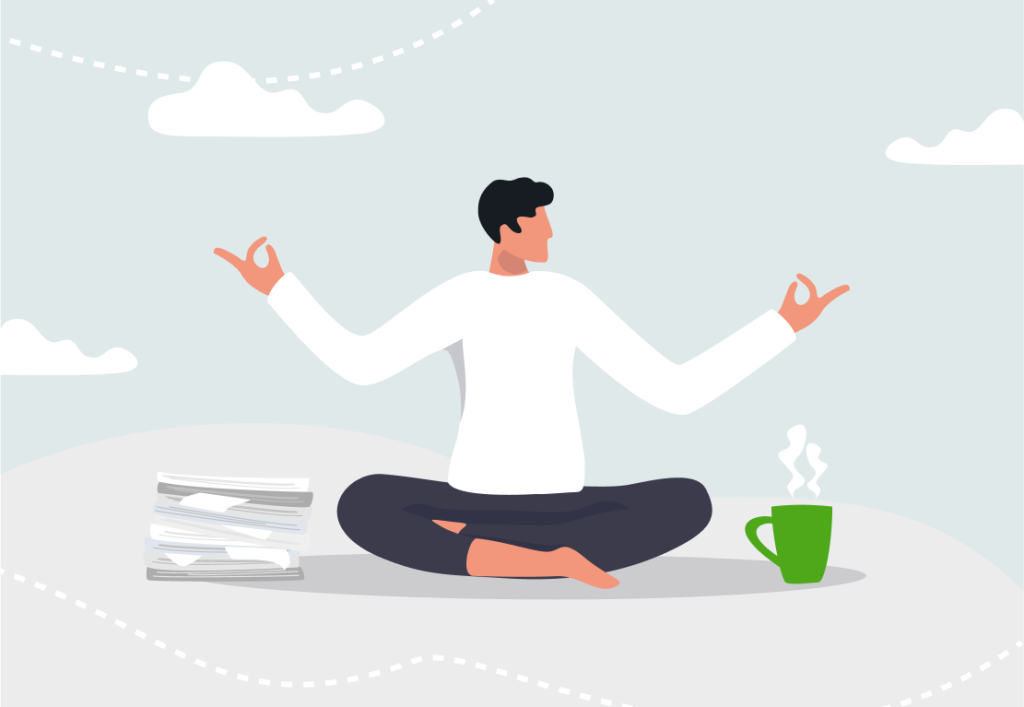Practicing mindfulness in the workplace: 7 meditative activities to help you regain focus at work

Amidst the myriad of tasks, deadlines, and distractions, achieving mindfulness in the workplace may seem like an impossible task.
When the amount of work is overwhelming, our stressed brain sort of blocks, and we may have difficulty concentrating or thinking logically. We’ve entered a vicious cycle where we cannot work because we’re stressed, and we’re stressed because we can’t get work done.
We don’t mean to scare you, but staying in such a state for extended periods is a recipe for burnout.
Take a deep breath.
We’ve got you.
This post covers 7 simple, yet powerful meditative techniques you can do when you can’t focus at work. Practice them regularly, and you’ll be on the right track to achieving mindfulness and avoiding burnout.
Want to get the most out of your time?
Try DeskTime for free!
Try free for 14 days · No credit card required.
By signing up, you agree to our terms and privacy policy.

1. Master breathing exercises
Breathing is the foundation of life and one of the most critical processes influencing how we feel and react. Ironically, the role of breathing is often forgotten as people try to fix their stress levels with external help like anti-stress pills or harmful habits.
The awareness of breathing starts by taking a few minutes to focus solely on your breath, inhaling and exhaling deeply. The key is to exclude all other thoughts and worries and focus only on your breath (this may not be simple at first).
Before starting a new task, you can also take a minute to pause, breathe, and mentally shift your focus to the new activity. This mini mindfulness activity at work can be practiced discreetly at your desk, and practicing it regularly can help calm your mind and reduce stress about your to-do list.

To achieve higher breathing awareness and mindfulness in the workplace, you can try breathing exercises. We’ve selected three breathing techniques suitable for practicing at the office or during work hours at home.
Deep abdominal breathing (diaphragmatic breathing):
- Sit or lie down comfortably,
- Place one hand on your chest and the other on your abdomen,
- Inhale deeply through your nose, feeling your abdomen expand as you fill your lungs with air,
- Exhale slowly through your mouth, feeling your abdomen fall,
- Repeat for several rounds, focusing on the rhythm and depth of your breaths.
4-7-8 breathing technique:
- Sit in a comfortable position,
- Inhale quietly through your nose for a count of four seconds,
- Hold your breath for a count of seven seconds,
- Exhale slowly and completely through your mouth for a count of eight seconds,
- Repeat this cycle for a few rounds.
Alternate nostril breathing:
- Sit comfortably and use your right thumb to close your right nostril,
- Inhale through the left nostril for a count of four seconds,
- Close the left nostril with your right ring finger, holding your breath for a count of four seconds,
- Release the right nostril and exhale for a count of four seconds,
- Inhale through the right nostril for a count of four seconds,
- Close the right nostril, hold, and release the left nostril to exhale,
- Repeat this cycle for several rounds.
2. Stretch or do yoga at your desk
If breathing exercises are not enough for you to reach mindfulness in the workplace (or if you’ve already mastered those and want more), try desk stretching or simple yoga poses. A significant added bonus – your muscles and joints will be thankful if you practice these exercises regularly.
Sitting for hours is harmful – it can limit the range of motion of many major areas in your body and may also contribute to poor posture, leading to aches and pains in the neck, shoulders, back, hips, forearms, wrists, and legs.
Moving for approximately three minutes every 30-60 minutes can help improve energy, mood, metabolism, and blood flow. Therefore, incorporating stretching and small exercises into your workday can be beneficial for your ability to focus and your overall physical health.
As a productivity tracking tool, we see many people worldwide working for too long stretches and taking too few breaks. That’s why we consulted a fitness coach who showed us simple stretching exercises to perform at your desk or during your break to release tension and promote mindfulness in the workplace. Watch this video for his expert tips on workday exercises:
3. Try guided meditation apps
Meditation may be among the most powerful mindfulness activities at work as it helps to reduce stress levels by activating the body’s relaxation response. Lower stress levels contribute to improved focus and productivity. Furthermore, mediation helps to handle workplace pressures, conflicts, and challenging situations in a more composed way.
If you’re unsure what to do when you can’t focus at work, meditation may indeed help. Regular meditation enhances cognitive function, including attention and concentration. To help you make meditation a habit, try using one of these apps that offer short guided meditations designed for quick breaks during the workday.
Headspace has the largest variety of meditations, with guided sessions for beginners and more advanced meditations for seasoned practitioners.
Calm is best for sleep and has a wide range of meditations, including guided sessions, breathing exercises, and bedtime stories.
Insight Timer is best for those on a budget and offers a wide range of free meditations, including guided sessions, music, and talks.

4. Keep a gratitude journal
Writing in a gratitude journal is a simple but powerful stress-relief technique. The idea is straightforward – write down three to five things you’re grateful for at work, promoting a positive mindset.
Don’t just stick to professional success or achievements. Some days, being grateful for a hot cup of coffee or a nice chat with a co-worker is enough. If you’ve encountered a failure or negative experience, try to transform your thinking by finding the positive side or the lesson in it.
With gratitude journaling, consistency is important. You should write in your journal every day, ideally – at the same time of day (it shouldn’t take more than five to ten minutes). After doing this for some time and making it a habit, you may begin to notice that you’re less stressed and start seeing small daily situations in a more positive light.
Your gratitude journal can take any format – it can be a beautiful notebook or an app that lets you jot down pleasant experiences and maybe add photos. The most important thing is to make journaling a quick and satisfying break in your intense workday, thus helping you achieve mindfulness in the workplace.

Want to prevent overworking?
Prioritize and set healthy boundaries!
5. Perform five senses check-in
“Five senses check-in” is a simple, quick, yet powerful mindfulness exercise at work that can help reduce symptoms of stress and anxiety. As the name suggests, this technique involves focusing on each of the five senses—sight, sound, touch, smell, and taste—to become more present and aware of your surroundings.
Here’s how it works:
- Sight: Notice and appreciate what you see around you. Observe the colors, shapes, and movements in your environment.
- Sound: Pay attention to the sounds around you, both near and far. Notice the different tones, volumes, and rhythms of the sounds.
- Touch: Focus on the things you can touch in your environment, notice their texture, temperature, and pressure.
- Smell: Take a few deep breaths and notice any scents in the air. Pay attention to the quality and intensity of the smells.
- Taste: If you have something to eat or drink, take a moment to savor the flavors and textures. If not, simply notice any lingering tastes in your mouth.
If you want to add a game element to this technique, try noticing five things you can see, four sounds, three things you can touch, two smells and one taste.
By engaging all your five senses, you can bring your attention to the present moment and away from anxious or stressful thoughts. This can help you feel more calm and grounded in the moment and achieve mindfulness in the workplace.

6. Practice mindful eating
Mindful eating is as simple as the name suggests – it’s about paying full attention to the experience of eating and drinking without judgment or distraction. But try it, and you may be surprised by how much you can enjoy your daily meal if you actually savor and appreciate it.
Begin by focusing on the food in front of you, engaging your senses to fully experience the colors, smells, tastes, textures, and even sounds. Observe your thoughts, feelings, and bodily sensations without labeling them as good or bad.
To turn eating into a mindfulness activity at work, it’s essential to eat slowly and avoid watching TV or working on the computer while eating. Take your time to chew your food thoroughly, savoring each bite. This allows for better digestion and enjoyment of the meal.
Of course, what you eat matters as much as how you eat. We recommend choosing balanced and nutritious meals as well as healthy brain food snacks to keep you satiated but alert and productive.
7. Take productivity-boosting naps
Taking short naps at work can have multiple benefits for your mind, body, and productivity levels. Research has shown that a brief nap during the workday can improve alertness, performance, and productivity. Power naps can sharpen the mind, improve memory, enhance decision-making, reasoning, and learning abilities, and even boost creativity.
But that’s not all. Napping has benefits for achieving mindfulness and improving your mental well-being as well. Short naps can lead to decreased tension, reduced anxiety, and a more relaxed state of mind. In the long term, napping can reduce fatigue, improve mood, and strengthen the immune system, leading to overall better health and well-being.
To take advantage of these benefits, it’s important to nap for the right length of time. Short power naps of 10-30 minutes are generally recommended to avoid sleep inertia, which can leave you feeling groggy.

Acing mindfulness in the workplace
If you often feel stressed or overwhelmed at work and have difficulties focusing, it may be time to do a mental cleanup and practice mindfulness in the workplace.
Your smartphone needs regular restarts and software updates to function properly. What makes us think our brain can go full speed without rest or regeneration?
We’ve covered how mindfulness techniques can heal your body and benefit your cognitive function and productivity. Practice them regularly and enjoy the benefits of a clearer mind and reduced mental clutter.
Did you find this article useful? Give it a clap!
Psst! You can clap more than once if you really loved it 🙂